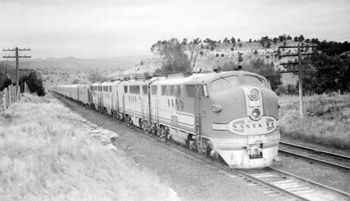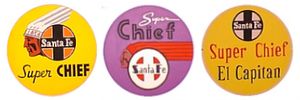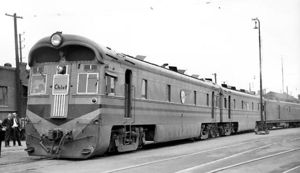Super Chief: Difference between revisions
imported>Robert A. Estremo (add images) |
imported>Robert A. Estremo (add images) |
||
| Line 2: | Line 2: | ||
[[Image:The Super Chief west of Trinidad, Colorado .jpg|thumb|right|350px|{{The Super Chief west of Trinidad, Colorado .jpg/credit}}<br />A quartet of EMD FT locomotives powers train No. 17, the ''Super Chief'', west of Trinidad, Colorado on September 1, 1946.]] | [[Image:The Super Chief west of Trinidad, Colorado .jpg|thumb|right|350px|{{The Super Chief west of Trinidad, Colorado .jpg/credit}}<br />A quartet of EMD FT locomotives powers train No. 17, the ''Super Chief'', west of Trinidad, Colorado on September 1, 1946.]] | ||
[[Image:ATSF Super Chief combined x3.png|thumb|300px|right|{{ATSF Super Chief combined x3.png/credit}}<br />"Drumhead" logo signs such as these often adorned the ends of observation cars on the ''Super Chief''.]] | [[Image:ATSF Super Chief combined x3.png|thumb|300px|right|{{ATSF Super Chief combined x3.png/credit}}<br />"Drumhead" logo signs such as these often adorned the ends of observation cars on the ''Super Chief''.]] | ||
The '''''Super Chief''''' was one of the [[Named passenger trains of the Atchison, Topeka and Santa Fe Railway|named passenger trains of the Atchison, Topeka and Santa Fe Railway]] (AT&SF). The railroad's flagship line (owing to the high level of service and popularity), it was often referred to as "The Train of the Stars" in acknowledgement of the many celebrities who traveled on the streamliner between [[Chicago, Illinois]] and [[Los Angeles, California]]. The ''Super Chief'' (assigned train Nos. 17 & 18) was the first diesel-powered, all-Pullman [[sleeping car]] train in America, and it eclipsed the ''[[Chief]]'' as Santa Fe's standard bearer. The extra-fare ''Super Chief-1'' commenced its maiden run from Chicago's Dearborn Station on May 12, 1936. Just over a year later, on May 18, 1937 the much-improved ''Super Chief-2'' traversed the 2,227.3 | [[Image:ATSF Super Chief-1.jpg|thumb|right|300px|{{ATSF Super Chief-1.jpg/credit}}<br />AT&SF diesel-electric units Nos. 1 and 1A are photographed at Los Angeles, California in May, 1936 in their original, as-delivered "golden olive" paint scheme.]] | ||
[[Image:Fa 472 enginethruwall970.jpg|thumb|right|300px|{{Fa 472 enginethruwall970.jpg/credit}}<br />Santa Fe #19L, leading the combined ''Super Chief / El Capitan'', comes to rest after smashing through a concrete barrier at Los Angeles Union Station in January, 1948.]] | |||
[[Image:Three for Bedroom C screenshot.jpg|thumb|right|300px|{{Three for Bedroom C screenshot.jpg/credit}}<br />Silent film star Gloria Swanson and actor James Warren in a scene from the 1952 Warner Bros. film ''Three for Bedroom C'', shot on board the ''Super Chief''.]] | |||
The '''''Super Chief''''' was one of the [[Named passenger trains of the Atchison, Topeka and Santa Fe Railway|named passenger trains of the Atchison, Topeka and Santa Fe Railway]] (AT&SF). The railroad's flagship line (owing to the high level of service and popularity), it was often referred to as "The Train of the Stars" in acknowledgement of the many celebrities who traveled on the streamliner between [[Chicago, Illinois]] and [[Los Angeles, California]]. The ''Super Chief'' (assigned train Nos. 17 & 18) was the first diesel-powered, all-Pullman [[sleeping car]] train in America, and it eclipsed the ''[[Chief]]'' as Santa Fe's standard bearer. The extra-fare ''Super Chief-1'' commenced its maiden run from Chicago's Dearborn Station on May 12, 1936. Just over a year later, on May 18, 1937 the much-improved ''Super Chief-2'' traversed the 2,227.3 miles (3,584.5 kilometers) from Los Angeles over recently upgraded tracks in just 39 hours and 49 minutes (averaging 60.8 miles-per-hour (98.0 km/h), often exceeding 100 miles-per-hour in the process). From that day forward the ''Super Chief'' set a new standard for luxury rail travel in America. With just the one set of equipment, the train initially operated only once a week from both Chicago and Los Angeles. However, at the height of its popularity, and with added equipment, the trains of the ''Super Chief'' made daily departures from both ends of the line. Adding to the train's mystique were its gourmet meals and [[Hollywood]] clientèle. | |||
Direct competitors to the ''Super Chief'' during its lifetime included the ''City of Los Angeles'', a streamlined passenger train jointly operated by the [[Chicago and North Western Railway]] and the [[Union Pacific Railroad]], and (to a lesser extent) the ''Golden State'', a streamlined passenger train jointly operated by the [[Chicago, Rock Island & Pacific Railroad|Rock Island]] and [[Southern Pacific Railroad|Southern Pacific]] railroads. Making its way through mostly sparsely populated areas (which enhanced the train's already distinctive aura), Santa Fe's route from Chicago to Los Angeles was the lengthiest of the high-speed, long distance trains of the day. The Santa Fe ''Super Chief'' was the last passenger train in the United States to carry an all-Pullman consist. The train maintained its legendary high level of service until the end of Santa Fe passenger operations on April 30, 1971. When [[Amtrak]] assumed operation of the nation's passenger service on May 1, 1971 it ended the 35-year run of the ''Super Chief'' on the Santa Fe, though the name would continue in use along the same route until 1974 when the Santa Fe forced Amtrak to drop the train's name due to a perceived decline in service. Amtrak subsequently operated the ''Southwest Limited'' over the same trackage. Following the delivery of new Superliner equipment, the Santa Fe compromised with Amtrak and the train became known as the ''Southwest Chief'' in 1984. | Direct competitors to the ''Super Chief'' during its lifetime included the ''City of Los Angeles'', a streamlined passenger train jointly operated by the [[Chicago and North Western Railway]] and the [[Union Pacific Railroad]], and (to a lesser extent) the ''Golden State'', a streamlined passenger train jointly operated by the [[Chicago, Rock Island & Pacific Railroad|Rock Island]] and [[Southern Pacific Railroad|Southern Pacific]] railroads. Making its way through mostly sparsely populated areas (which enhanced the train's already distinctive aura), Santa Fe's route from Chicago to Los Angeles was the lengthiest of the high-speed, long distance trains of the day. The Santa Fe ''Super Chief'' was the last passenger train in the United States to carry an all-Pullman consist. The train maintained its legendary high level of service until the end of Santa Fe passenger operations on April 30, 1971. When [[Amtrak]] assumed operation of the nation's passenger service on May 1, 1971 it ended the 35-year run of the ''Super Chief'' on the Santa Fe, though the name would continue in use along the same route until 1974 when the Santa Fe forced Amtrak to drop the train's name due to a perceived decline in service. Amtrak subsequently operated the ''Southwest Limited'' over the same trackage. Following the delivery of new Superliner equipment, the Santa Fe compromised with Amtrak and the train became known as the ''Southwest Chief'' in 1984. | ||
Revision as of 14:06, 25 September 2014
The Super Chief was one of the named passenger trains of the Atchison, Topeka and Santa Fe Railway (AT&SF). The railroad's flagship line (owing to the high level of service and popularity), it was often referred to as "The Train of the Stars" in acknowledgement of the many celebrities who traveled on the streamliner between Chicago, Illinois and Los Angeles, California. The Super Chief (assigned train Nos. 17 & 18) was the first diesel-powered, all-Pullman sleeping car train in America, and it eclipsed the Chief as Santa Fe's standard bearer. The extra-fare Super Chief-1 commenced its maiden run from Chicago's Dearborn Station on May 12, 1936. Just over a year later, on May 18, 1937 the much-improved Super Chief-2 traversed the 2,227.3 miles (3,584.5 kilometers) from Los Angeles over recently upgraded tracks in just 39 hours and 49 minutes (averaging 60.8 miles-per-hour (98.0 km/h), often exceeding 100 miles-per-hour in the process). From that day forward the Super Chief set a new standard for luxury rail travel in America. With just the one set of equipment, the train initially operated only once a week from both Chicago and Los Angeles. However, at the height of its popularity, and with added equipment, the trains of the Super Chief made daily departures from both ends of the line. Adding to the train's mystique were its gourmet meals and Hollywood clientèle.
Direct competitors to the Super Chief during its lifetime included the City of Los Angeles, a streamlined passenger train jointly operated by the Chicago and North Western Railway and the Union Pacific Railroad, and (to a lesser extent) the Golden State, a streamlined passenger train jointly operated by the Rock Island and Southern Pacific railroads. Making its way through mostly sparsely populated areas (which enhanced the train's already distinctive aura), Santa Fe's route from Chicago to Los Angeles was the lengthiest of the high-speed, long distance trains of the day. The Santa Fe Super Chief was the last passenger train in the United States to carry an all-Pullman consist. The train maintained its legendary high level of service until the end of Santa Fe passenger operations on April 30, 1971. When Amtrak assumed operation of the nation's passenger service on May 1, 1971 it ended the 35-year run of the Super Chief on the Santa Fe, though the name would continue in use along the same route until 1974 when the Santa Fe forced Amtrak to drop the train's name due to a perceived decline in service. Amtrak subsequently operated the Southwest Limited over the same trackage. Following the delivery of new Superliner equipment, the Santa Fe compromised with Amtrak and the train became known as the Southwest Chief in 1984.
History
Timeline
- August 1935: General Motors Electro-Motive Division (EMD) delivers two blunt-nosed diesel-electric units Nos. 1 and 1A, which would ultimately power the Super Chief.
- September 9, 1935: Nos. 1 and 1A make their first test run under load with eight heavyweight passenger cars and a dynamometer car.
- May 12, 1936: The Santa Fe inaugurates the all-diesel powered Super Chief-1 amid much fanfare. Eleanor Powell, Hollywood's legendary dancer, christens it "The Train of the Stars."
- May 10, 1937: The last of four "preview" runs of the Super Chief-2, which utilizes an improved 3,600 hp (2.7 MW), two-unit, streamlined diesel locomotive set built by EMD as motive power, concludes as the train pulls into Union Station in Los Angeles. All heavyweight wood cars used on the Super Chief are replaced with lightweight stainless steel cars. The general public is invited to tour the new train at Santa Fe's La Grande Station on May 11th and 12th.
- May 15, 1937: The Super Chief-2 departs Los Angeles at 7:30 p.m. PST. The train completes its maiden run in just 36 hours and 49 minutes (2 hours and 56 minutes ahead of schedule), setting a new Santa Fe speed record in the process, one that would never be broken. It would subsequently be determined that both of the new E1 units suffered mechanical damage during the trip east, and they would be taken out of service for repairs.
- May 18, 1937: The Super Chief-2 commences its first regular run, led by Unit 1A and EMD demonstrator Unit 512 (a.k.a. AT&SF Unit 1C), as it departs Chicago's Dearborn Station. The passenger list includes ventriloquist Edgar Bergen and his "sidekick" Charlie McCarthy.
- January 1938: E1 Units 3 and 3A are added to the Santa Fe roster and placed into service on the Super Chief-2.
- February 26, 1938: A "borrowed" six-car Chief consist begins operating as the Super Chief-2½ due to production delays in order to provide twice-weekly service on the line.
- July 2, 1938: A second, all-lightweight trainset built by Pullman-Standard enters service as the Super Chief-3 and officially replaces the Super Chief-2½.
- 1941: The Santa Fe takes delivery of its only 2,000 hp (1.5 MW) ALCO DL-109/110 model locomotives, Units 50 and 50A respectively, which become the primary motive power for the Super Chief-3.
- July 7, 1942: The Super Chief goes on a wartime schedule of 41 hours, 45 minutes. Consist size expands to 12 cars, and each logs 636 daily miles.
- June 2, 1946: The line reverts to its prewar schedule of 39 hours and 45 minutes.
- September 29, 1946: The Super Chief begins an every-other-day departure schedule from Chicago and Los Angeles.
- January 25, 1948: Locomotive #19L, leading the Super Chief, loses braking ability while preparing to depart Los Angeles' Union Passenger Terminal (LAUPT). The train crashes through a steel bumper post and then a concrete wall located at the end of the dead-end track, and ultimately comes to rest with the front half of the locomotive dangling 20 feet (6 m) above the street below. Although there are no injuries, the engineer loses his job over the incident.
- February 29, 1948: The AT&SF receives the first post-War equipment order from Pullman-Standard and places these into service on the Super Chief. The railroad now has five Super Chief trainsets and the frequency of operation is upgraded to daily.
- December 29, 1949: Train No. 17, led by locomotive set #37L/A/B/C, collides with a tanker truck in Azusa, California. All four locomotives, baggage car #3409, and railway post office #88 are damaged by fire.
- 1950–1951: The Super Chief is re-equipped with new sleeping cars built by the Budd Company and the American Car and Foundry Company (ACF), and dining cars from Pullman-Standard. Santa Fe also adds the Pullman-built "Pleasure Dome"-Lounge car (one of the most luxurious ever made for any train) to its Super Chief consists, billing it as the "...only dome car between Chicago and Los Angeles." A speedometer located in the front of the car allowed passengers to monitor the train's velocity.
- June 1952: The Super Chief is prominently featured in the Warner Bros. film Three for Bedroom C starring Gloria Swanson.
- 1954: The General Tire and Rubber Company utilizes the Super Chief as the centerpiece of a print advertisement for its new "Nygen Cord" tire, in which the train is towed by an AT&SF switcher utilizing one of the tires as a connecting link.
- January 10, 1954: The $15.00 extra-fare charge is reduced to $7.50; the barbershop, shower-bath, and coast-to-coast Pullman (which ran through to New York by way of The Broadway Limited and the 20th Century Limited) are all discontinued.
- 1956: Santa Fe transfers Transcontinental Sleeping Car Service to the Chief. Round-end observation cars are removed from Super Chief service, converted to blunt-ended cars at Pullman's Calumet, Illinois shops, and returned to train Nos. 17 and 18. In early 1958 they are permanently removed from Super Chief service.
- Jauary 12, 1957: The Super Chief and El Capitan are combined into one train during the off-peak travel season on a 39½-hour schedule.
- 1958]]: All five Super Chief trainsets are refurbished and redecorated.
- August 21, 1964: A rail from a passing train "spears" coach #2804 in Kingman, Arizona.
- January 6, 1969: Locomotives #46L, #39C, #310B, #45B, and #44A derail due to unknown causes in Holcomb, Kansas. Cars #2924, #2866, #1563, #539, #713, #714, #650, #578, #712, #716, #707, and #526 leave the tracks as well.
- May 1, 1971: Amtrak is formed and takes over operation of the nation's passenger service, thus ending 35 years of the Santa Fe Super Chief. Amtrak retains the use of the Super Chief / El Cap names, with the Santa Fe's concurrence.
- 1973: Amtrak drops the El Capitan designation.
- March 7, 1974: The Santa Fe directs Amtrak to discontinue use of the names Super Chief (which then becomes the Southwest Limited) and Texas Chief (which is renamed the Lone Star) due to a perceived reduction in the quality of service provided on the routes.
- November 30, 1980: Amtrak's "Superliners" replace the "Pleasure Dome" and "Hi-Level" cars on the Southwest Limited.
- October 28, 1984: Due to improvements in service, the Santa Fe allows Amtrak to change the name of the Southwest Limited to the Southwest Chief.
- August 26, 1999: The United States Postal Service issues 33-cent All Aboard! 20th Century American Trains commemorative stamps featuring five celebrated American passenger trains from the 1930s and 1940s. One of the five stamps features an image of EMD E1 Unit No. 6 adorned in the Super Chief's "warbonnet" livery.




